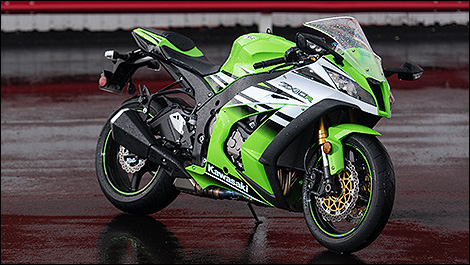Kawasaki practically invented superbike races a little more than 30 years ago when Eddie Lawson ruled the tracks with a KZ1000. The performance-obsessed Japanese manufacturer always makes every possible effort to win championships, so it should come as no surprise that the latest Ninja ZX-10R dominates the field in international superbike competitions -- it’s a fearsome weapon backed by high-tech rider-assist systems.
After six seasons without a win in motoGP, Kawasaki executives decided to focus on the WSBK championship, where success on the track actually benefits a company’s bottom line.
Expertise put to good use
The 2015 Kawasaki Ninja ZX-10R is a model of electronic wizardry, one with a smooth and linear power delivery for exemplary control and rider friendliness.
With the acclaimed S-KTRC traction control system and KIBS antilock braking system, Kawasaki made history in 2011 by becoming the first Japanese brand to offer a production superbike equipped with both of these advanced technologies (the Yamaha YZF-R1 followed that up in 2015).
The three engine maps and three traction control modes can all be selected via a switch near your left thumb. You don’t need to cut power or put the transmission in neutral; just tug at the clutch lever and change gears. Nothing could be easier.
Questionable styling
The 2015 Kawasaki Ninja ZX-10R won’t appeal to everyone based on looks (notice the somewhat bizarre plastics around the tank and dubious design in the rear), but you will quickly forget about it once you check out the super-sophisticated and comprehensive instrument panel.
And who the heck bothers with styling when you get to enjoy a new aluminum twin-spar frame with a swingarm designed to put 185 hp to the ground? Project chief Yoshihiro Masuda and his team of engineers strove to improve the bike’s agility and handling, which is further evidenced by the smaller frame size and horizontal shock position.
Effective and transparent
At the conclusion of our first session on the track, I was impressed the most by the effectiveness and transparency of the S-KTRC and KIBS systems. No matter how hard I pushed the ZX-10R, the rear wheel never swayed, and the factory-installed tires never slipped. I know of a few corner exits where numerous other bikes I tested could not deliver the same amount of traction or the same level of rider confidence.
In Mode 1 (dry track), the S-KTRC rarely intervenes and you completely forget about it. In a wise move, Kawasaki equipped the bike with a level indicator so you can know how much help it provides at any given time.
The thing that amazed me was how quickly the system analyzes what’s going on and then reacts accordingly, preventing slippage by engaging right as you twist the throttle, but never excessively so. It’s like a guardian angel ready to pull you out of trouble if the adrenaline rush gets the better of you. I thought for sure the bike could read my mind, but in reality the system monitors a number of parameters every five milliseconds to predict when conditions will be less than favourable and respond immediately.
 |
| The performance-obsessed Japanese manufacturer always makes every possible effort to win championships, so it should come as no surprise that the latest Ninja ZX-10R dominates the field in international superbike competitions. (Photo: Sébastien D'Amour) |
Making corner exits memorable
As I leaned over the apex and blasted out of corners by holding the second gear all the way to redline, the bike’s tail barely deviated a few millimetres. I felt like a pro racer inducing a wee bit of drifting and leaving a black mark along the way. With or without S-KTRC, you have to admit that rear-wheel traction is phenomenal for a machine with a nearly 1:1 power-to-weight ratio.
Four years after the launch of the latest generation, the 2015 Kawasaki Ninja ZX-10R still ranks among the highest-performing superbikes on the market. Direct rivals from Europe have few edges over it, and all other Japanese contenders are following its lead.
Pros
- Fantastic electronic nannies
- Highly competent chassis
- Easy to exploit
- A ton of fun on the track
Cons
- Rear-end styling needs work
- Some rear suspension adjustments needed for ultimate track performance

